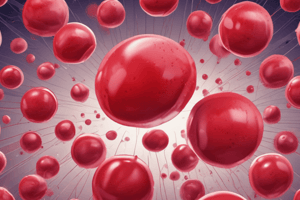Podcast
Questions and Answers
Normal total cholesterol level is less than ____ mg/dL.
Normal total cholesterol level is less than ____ mg/dL.
200
LDL (bad) cholesterol level should be less than ____ mg/dL.
LDL (bad) cholesterol level should be less than ____ mg/dL.
130
What is the normal HDL (good) cholesterol level for females?
What is the normal HDL (good) cholesterol level for females?
- Greater than 55 mg/dL (correct)
- Less than 45 mg/dL
- Greater than 45 mg/dL
- Less than 55 mg/dL
What is the normal triglyceride level for males?
What is the normal triglyceride level for males?
What does a high HDL level do for coronary arteries?
What does a high HDL level do for coronary arteries?
What causes pernicious anemia?
What causes pernicious anemia?
What are the signs and symptoms of iron deficiency anemia?
What are the signs and symptoms of iron deficiency anemia?
What is the management for sickle cell disease?
What is the management for sickle cell disease?
Which of the following blood products is used to replace coagulation factors in hemophilia?
Which of the following blood products is used to replace coagulation factors in hemophilia?
Febrile non-hemolytic reaction is the most common type of blood transfusion reaction.
Febrile non-hemolytic reaction is the most common type of blood transfusion reaction.
What are the expected findings of hypokalemia?
What are the expected findings of hypokalemia?
What interventions should be implemented to prevent postoperative complications?
What interventions should be implemented to prevent postoperative complications?
Identify a risk factor for malignant hyperthermia.
Identify a risk factor for malignant hyperthermia.
What are key interventions for skin cancer prevention?
What are key interventions for skin cancer prevention?
What vital signs monitoring should be done for clients at risk for neutropenia?
What vital signs monitoring should be done for clients at risk for neutropenia?
Which of the following patients are at risk for aspiration?
Which of the following patients are at risk for aspiration?
What are common risk factors for pneumonia?
What are common risk factors for pneumonia?
Identify appropriate interventions for clients in airborne precautions.
Identify appropriate interventions for clients in airborne precautions.
What is a key nursing intervention for clients with hypoxemia?
What is a key nursing intervention for clients with hypoxemia?
What is an important aspect of medication education related to TB medications?
What is an important aspect of medication education related to TB medications?
Study Notes
Anemia Types
-
Pernicious Anemia
- Deficiency of Vitamin B12 or intrinsic factor lack.
- Symptoms: pallor, tachycardia, confusion, smooth red tongue, fatigue.
- Diagnosed via B12 panel.
- Management includes oral B12 or lifelong monthly IM injections if intrinsic factor is absent.
-
Iron Deficiency Anemia
- Caused by low iron intake, often due to GI bleeding.
- Symptoms: similar to pernicious anemia with brittle nails.
- Diagnosis through bone marrow aspiration and iron lab values.
- Managed with iron supplements, dietary changes, and vitamin C for absorption.
-
Sickle Cell Disease
- Genetic disorder resulting in defective hemoglobin.
- Symptoms: jaundice, pain, tachycardia, increased infection risk.
- Diagnosis: low hematocrit and sickled cells identified in blood.
- Treatments include stem cell transplants, hydroxyurea, and pain management.
Blood Transfusion Protocols
- Ensure signed informed consent is documented.
- Conduct type and cross-match with double identification verification.
- Verify patient identity and blood compatibility upon receipt of blood product.
- Check blood appearance for discoloration before administration.
Blood Products Uses
- Whole Blood Cells: Large volume replacement; contains all blood components.
- Red Blood Cells: For blood loss and anemia treatment.
- Fresh Frozen Plasma: Replaces coagulation factors during massive hemorrhage.
- Platelets: Used for thrombocytopenia and aplastic anemia.
- Granulocytes: Treats severe neutropenia and ongoing infections.
- Cryoprecipitate: Controls bleeding in hemophilia and low fibrinogen.
- Albumin: Addresses hypovolemia and various conditions requiring fluid support.
Transfusion Reactions
-
Febrile Non-Hemolytic Reaction
- Most common; occurs within 2 hours.
- Symptoms include chills, fever, flushing.
- Management: stop transfusion, administer antipyretics, monitor.
-
Acute Hemolytic Reaction
- Can occur immediately or with subsequent transfusions.
- Symptoms: fever, back pain, anxiety, hemoglobinuria.
- Management includes stopping transfusion, monitoring vitals, sending blood/tubing for testing.
-
Allergic Reaction
- Occurs during or up to 24 hours post-transfusion.
- Symptoms: urticaria, bronchospasm, hypotension.
- Management: stop transfusion, administer antihistamines, monitor.
-
Transfusion-Related Acute Lung Injury (TRALI)
- Onset within 6 hours.
- Symptoms include dyspnea, hypoxia, pulmonary edema.
- Management focuses on airway support and oxygen therapy.
-
Bacterial Contamination Reaction
- Most common with platelets.
- Symptoms: fever, chills, signs of sepsis.
- Management: stop transfusion, administer antibiotics, send cultures.
Electrolyte Imbalances
- Potassium Levels 3.5-5.0 mEq/L.
- Hypokalemia: Causes include diuretics, GI loss; symptoms are muscle weakness, fatigue.
- Hyperkalemia: Causes include ACE inhibitors, renal issues; symptoms involve cardiac dysrhythmias, anxiety.
Arterial Blood Gases (ABGs) Interpretation
- Normal Values: pH 7.35-7.45, PaCO2 35-45 mm Hg, HCO3 22-26 mEq/L.
- Metabolic Acidosis: Low pH and bicarbonate; indicates kidney injury.
- Metabolic Alkalosis: High pH and bicarbonate; often due to vomiting.
- Respiratory Acidosis: Low pH and high PaCO2; related to respiratory disorders.
- Respiratory Alkalosis: High pH and low PaCO2; often from hyperventilation.
Perioperative Nursing
- Baseline VS assessment every 15 minutes for the first hour; then every 30 minutes.
- Assess surgical sites for drainage and tubes.
- Maintain airway and manage pain and anxiety.
- Cardiovascular stability is essential; hypotension indicates significant blood loss.
Informed Consent
- Surgeon responsibilities: Explain procedure, risks, benefits, and alternatives.
- Nurse roles: Witness consent signing, ensure understanding, advocate for patient queries.
Risk Factors for Malignant Hyperthermia
- Strong muscles, history of muscle cramps, unexplained family deaths during surgery.
Cancer Prevention Interventions
- Skin Cancer Prevention: Avoid sun exposure between 10-4, wear protective clothing and sunscreen.
- Regular skin self-examinations recommended.
Neutropenia Client Care
- Monitor vital signs and WBC levels; maintain strict hygiene practices.
- Isolate clients with low WBC counts and educate visitors about hygiene.
Aspiration Risk Factors
- Identified risk in patients with seizures, decreased LOC, or swallowing disorders.
- Interventions include proper positioning and checking tube feedings for placement.
Pneumonia Risk Factors
- Key demographics include individuals over 65 and those with chronic lung disease or mobility issues.
Hypoxemia Care Priorities
- Administer oxygen therapy, monitor pulse oximetry, and position patient appropriately for optimal breathing.
Tuberculosis Medication Education
- Emphasize strict adherence to medication regimen for 6-12 months to prevent resistance.
- Regular sputum sampling is crucial to assure non-infectious status.
Lipid Panel Values
- Total Cholesterol: <200 mg/dL; LDL: <130 mg/dL; HDL: >55 mg/dL (female), >45 mg/dL (male).
- Triglycerides: F: 35-135 mg/dL, M: 40-160 mg/dL.
Blood Pressure Classifications
- Understanding the distinctions among normal and high blood pressure readings critical for monitoring cardiovascular health.
Studying That Suits You
Use AI to generate personalized quizzes and flashcards to suit your learning preferences.
Related Documents
Description
Explore the various types of anemia, including pernicious anemia, iron deficiency anemia, and sickle cell disease. This quiz also covers essential blood transfusion protocols and management strategies for each condition. Test your knowledge on symptoms, diagnosis, and treatment options.




